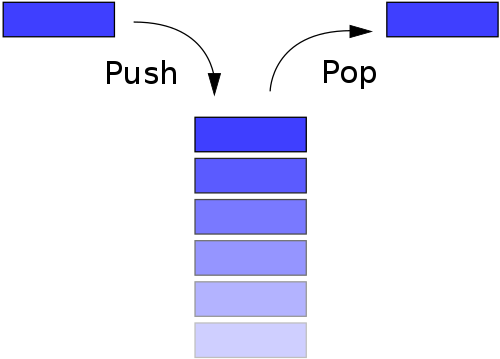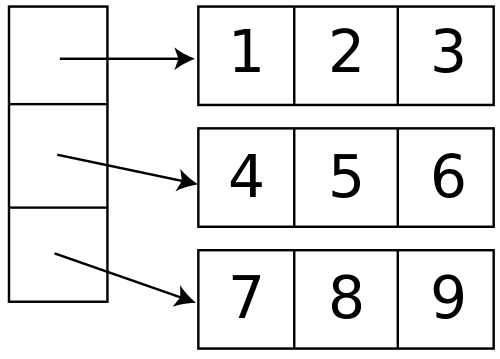Difference Between Stack and Array
Data structures are the building blocks of many things you wish to accomplish like storing and organizing data in a predescribed format so that it can be accessed and modified in efficient ways. It makes it easy for you to locate and retrieve information as required. Data structures are basically logical representation of data used to store ordered data so that various operations can be performed on them. We have multiple ways to store and retrieve information within in computer program. Stack and Array are two most common ways to store data in Object-oriented programming language. Well, you can certainly implement a stack with an array. However, the main difference between the two is access.

What is Stack?
A stack is a linear, list-like data structure represented by a sequential collection of elements in analogy with a physical stack or a pile where the items are arranged on top of each other like a pile of books. The items are so arranged that new items can be added or existing items can be removed from one end only called the top of the stack. Stack is a dynamic data structure whose size constantly changes as items are pushed and popped from the stack. Push and pop are the two basic operations performed on a stack. Push means the items are added into the stack and pop means objects are removed from the stack. It follows a fixed order called LIFO (last-in-first-out) meaning the recently added items is the first to be out and first item added is the last one to be out from the stack.

What is Array?
An array is a linear data structure which is always defined as a collection of elements of similar data types and the value is stored at a predetermined location called the index of the array. Unlike stacks, arrays are static objects whose size remains same throughout meaning once an array has been allocated, its size cannot be modified. It is one of the efficient ways to perform similar kind of computations on multiple elements that belong to the same data type. It can store one or more values of a similar data type and provide access to them by their indices. It is a random-access data structure where the objects are stored linearly and can be accessed at any time.
Difference between Stack and Array
Meaning of Stack and Array
Stack is a linear data structure that can be thought as a basic data structure represented by a collection of items arranged in the form of a physical stack or a pile. Stack is a sequential collection of objects arranged in a particular order so that objects can be inserted and removed from one end only, which is from the top of the stack. An array, on the other hand, is a random access data structure used to store large number of data values to reduce the complexity of the program. In an array, the objects are stored linearly, one after another for efficient memory management.
Data Type
A stack is an abstract data type that represents a sequential collection of objects that may store heterogeneous data meaning it can contain various data that belong to different data types. It is a limited-access data structure in which the objects can be added or removed in a particular order. An array will only store homogenous data meaning it refers to the collection of similar data types. Arrays are fixed in size and will only accept same type of data. Unlike stacks, arrays have a list of ordered elements that can be accessed at any time.
Working Principle
A stack is a linear data structure which anticipates organization of data in a fixed order, which in this case is LIFO or FILO. The elements can be added and removed from one end only called the top of the stack in a Last-In-First-Out (LIFO) order meaning the recently added object is the first to be removed from the stack or the first one in should be removed last (FILO). An array is a collection of objects which you can access at any time meaning objects can be inserted and removed randomly irrespective of their order.
Operations
Stack is an ordered representation of objects with two basic operations: push and pop. It refers to the analogy of arrangement of objects on top of each other like a pile of books. Push is used to insert objects into the stack whereas pop removes objects from the stack. These two operations append objects to the collection and remove an object from the collection respectively. Many operations can be performed on an array such as Traversing, Insertion, Deletion, Searching, Sorting, and Merging. An array can have multiple elements with each element holding a single value.
Stack vs. Array: Comparison Chart

Summary of Stack vs. Array
Although both are the most efficient ways for storing and accessing data and you can certainly implement a stack with an array with the exception of working principle and access control. A stack is a basic representation of collection of items in a data structure where the items are arranged in a particular order so that they can be inserted and removed from one end only, which is from the top of the stack in a LIFO or FILO order. An array is a static object where the number of items is fixed and unlike stacks, items in an array can be added and removed from either end regardless of the order.
- Difference Between Caucus and Primary - June 18, 2024
- Difference Between PPO and POS - May 30, 2024
- Difference Between RFID and NFC - May 28, 2024
Search DifferenceBetween.net :
Leave a Response
References :
[0]Image credit: https://upload.wikimedia.org/wikipedia/commons/thumb/0/01/Array_of_array_storage.svg/500px-Array_of_array_storage.svg.png
[1]Image credit: https://upload.wikimedia.org/wikipedia/commons/thumb/2/29/Data_stack.svg/500px-Data_stack.svg.png
[2]Aho, Alfred V. Data Structures and Algorithms. New Delhi: Pearson Education India, 2002. Print
[3]Vitter, Jeffrey Scott. Algorithms and Data Structures for External Memory. Breda, Netherlands: Now Publishers, 2008. Print
[4]Dale, Nell, et al. Object-Oriented Data Structures Using Java. Burlington: Jones & Bartlett Publishers, 2016. Print
